|
|
The end of Langkasuka
The rise and fall of the Malay kingdom
of Patani.
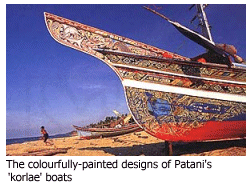 Patani
probably rivals Kedah as among the oldest Malay states on the
Peninsula. The lost Second Century kingdom of Langkasuka may have
spanned the peninsula from Patani on the east coast, to northern Kedah
on the west. Wu-pei-chih, certainly firmly places a Lang-hsi-chia to
the south of Songkla (Singora), up to the Patani River and the fabled
spirit land of Lakawn Suka still features in the mythology of Patani
Malays. Patani was probably one of the Sri Vijayan empire's conquests
and ' Ilangasoka, undaunted in fierce battles' was certainly recorded
as one of Rajendra Cola's conquests in his raids into Southeast Asia
into the empire in 1025. Patani
probably rivals Kedah as among the oldest Malay states on the
Peninsula. The lost Second Century kingdom of Langkasuka may have
spanned the peninsula from Patani on the east coast, to northern Kedah
on the west. Wu-pei-chih, certainly firmly places a Lang-hsi-chia to
the south of Songkla (Singora), up to the Patani River and the fabled
spirit land of Lakawn Suka still features in the mythology of Patani
Malays. Patani was probably one of the Sri Vijayan empire's conquests
and ' Ilangasoka, undaunted in fierce battles' was certainly recorded
as one of Rajendra Cola's conquests in his raids into Southeast Asia
into the empire in 1025.
 Patani
is also probably one of the earliest Malay states to convert to Islam -
certainly well before Melaka. The Hikayat Patani tells the story of its
king Raja Phya Tu Nakpa who falls gravely ill, with no apparent cure to
his ailment in sight. A holy man by the name of Syeikh Said claims he
can cure the ruler but only if he promises to convert to Islam as soon
as he is healthy. The desperate ruler promises to do so and, as a
result, he makes a miraculous recovery. However, he forgets his promise
and falls ill, and again seeks the holy man's blessings. This happens
three times - but he finally makes good on his promise the third time
and becomes a Muslim, calling himself Sultan Ismail Shah. Patani
is also probably one of the earliest Malay states to convert to Islam -
certainly well before Melaka. The Hikayat Patani tells the story of its
king Raja Phya Tu Nakpa who falls gravely ill, with no apparent cure to
his ailment in sight. A holy man by the name of Syeikh Said claims he
can cure the ruler but only if he promises to convert to Islam as soon
as he is healthy. The desperate ruler promises to do so and, as a
result, he makes a miraculous recovery. However, he forgets his promise
and falls ill, and again seeks the holy man's blessings. This happens
three times - but he finally makes good on his promise the third time
and becomes a Muslim, calling himself Sultan Ismail Shah.
It is under Sultan Ismail Shah's reign that the state takes on
the name 'Patani'. Seeking a location for a new capital, he comes
across an ideal spot on the coast and exclaims to his followers 'Pantai
Ini!' ('This beach!). Another account says that he finds a farmer's hut
at this spot and calls his capital 'Pak Tani' ('farmer'). This capital
is thought to be in modern day Kampong Grisek (Kru Se).
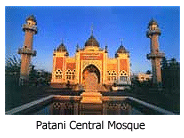 Patani
was certainly known to the Portuguese, who first visited the port in
1516, with Godinho de Eredia going as far as describing 'Patane' as the
first seat of the Malay Empire. The fall of Melaka to the Portuguese in
1511 certainly increased Patani's popularity with India's Muslim
traders. Its location on the east coast of the Peninsula gave it the
added advantage of being the ideal emporium for goods from China. This
economic growth may have strengthened its military power as well.
Taking advantage of a massive invasion of Ayutthaya by the Burmese in
1563, Sultan Ismail's successor, Sultan Muzaffar Shah, launched an
attack on the Siamese, with 200 ships and thousands of men. He died
suddenly during the campaign and is said to be buried at the estuary of
the Menam Chao Phraya. Patani
was certainly known to the Portuguese, who first visited the port in
1516, with Godinho de Eredia going as far as describing 'Patane' as the
first seat of the Malay Empire. The fall of Melaka to the Portuguese in
1511 certainly increased Patani's popularity with India's Muslim
traders. Its location on the east coast of the Peninsula gave it the
added advantage of being the ideal emporium for goods from China. This
economic growth may have strengthened its military power as well.
Taking advantage of a massive invasion of Ayutthaya by the Burmese in
1563, Sultan Ismail's successor, Sultan Muzaffar Shah, launched an
attack on the Siamese, with 200 ships and thousands of men. He died
suddenly during the campaign and is said to be buried at the estuary of
the Menam Chao Phraya.
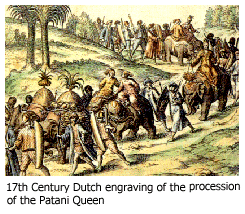 In
1584, Patani entered its golden age with the rule of four successive
Queens, Ratu Hijau ('The Green Queen'), Ratu Biru ('The Blue Queen'),
Ratu Ungu ('The Violet Queen') and Ratu Kuning ('The Yellow Queen').
Patani expanded its borders to include Kelantan and Trengganu and
became the most powerful Malay state after Johor. It was during this
time that Patani became renowned for manufacturing cannon, producing
three of the largest bombards ever cast in the region - 'Mahalela',
'Seri Negara' and 'Seri Petani'. With each measuring over six metres in
length. In
1584, Patani entered its golden age with the rule of four successive
Queens, Ratu Hijau ('The Green Queen'), Ratu Biru ('The Blue Queen'),
Ratu Ungu ('The Violet Queen') and Ratu Kuning ('The Yellow Queen').
Patani expanded its borders to include Kelantan and Trengganu and
became the most powerful Malay state after Johor. It was during this
time that Patani became renowned for manufacturing cannon, producing
three of the largest bombards ever cast in the region - 'Mahalela',
'Seri Negara' and 'Seri Petani'. With each measuring over six metres in
length.
Certainly, this technology may have contributed to Patani
successfully beating back no less than four Siamese invasions in - at
times with the help of Malay forces from Johor and Pahang.
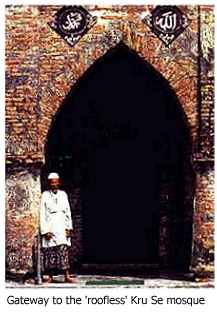 However,
by the middle of the 17th Century, during the reign of the last of the
Queens, Patani fell into gradual decline. This decline probably
prompted her to submit to Siam as a vassal state and send the 'Bunga
Mas' to Ayutthya. She died without an heir and the country descended
into decades of political chaos and conflict. Fortunately for Patani,
Siam was too weak to take advantage of the situation, being too busy
driving off crippling Burmese invasions into her territory, culminating
in the pillaging and complete destruction of Ayutthaya in 1767. However,
by the middle of the 17th Century, during the reign of the last of the
Queens, Patani fell into gradual decline. This decline probably
prompted her to submit to Siam as a vassal state and send the 'Bunga
Mas' to Ayutthya. She died without an heir and the country descended
into decades of political chaos and conflict. Fortunately for Patani,
Siam was too weak to take advantage of the situation, being too busy
driving off crippling Burmese invasions into her territory, culminating
in the pillaging and complete destruction of Ayutthaya in 1767.
The Siamese general Phraya Taksin led a war of independence
that drove the Burmese out of Siam and his successor Rama I established
the Chakri dynasty, which was to rule Siam to this day. A resurgent and
much stronger Siam demanded troops and supplies from Patani to face yet
another Burmese raid.
When Patani's Sultan Muhammad was reluctant to send troops,
Rama I's son, Prince Surasi, attacked Patani in 1786. Sultan Muhammad
was slain in battle and his capital was burned to the ground. 4,000
Patani Malays were brought in chains and marched barefoot the 1,300 km
to Bangkok. It was said that the captives had to have their ear lobes
and legs sewn together with strong rattan to prevent escape. In
Bangkok, they became slaves and were made to dig the city's system of
canals or 'klongs'.
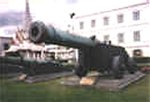 As
the ultimate humiliation, the symbols of Patani's strength and power -
the 'Seri Negara' and 'Seri Patani' cannons - were brought in triumph
to Bangkok . Both can still be seen today gracing the entrance to
Thailand's Ministry of Defence building. As
the ultimate humiliation, the symbols of Patani's strength and power -
the 'Seri Negara' and 'Seri Patani' cannons - were brought in triumph
to Bangkok . Both can still be seen today gracing the entrance to
Thailand's Ministry of Defence building.
Further rebellions erupted in Patani in 1791 and 1808,
following which Patani was partitioned into seven states - Patani,
Teluban (Sai), Nongcik, Jalor (Yala), Jambu(Jering), Legeh (Rangae) and
Reman - and administered directly by the Raja of Ligor. There were few
months of independence when four of the states joined the Kedah Malays
in driving the Siamese out of the peninsula - but their success was
short-lived and they were re-conquered easily. In 1906, the seven
states were reconstituted into a single province. From the mythical
Langkasuka to the seat of Malay empire, the province of Patani was now
formally annexed as an administrative division of the Kingdom of
Thailand.
Sources:
Ibrahim Syukri, Sejarah Kerajaan Melayu Patani,
Kota Bharu: Percetakan Pasir Putih, ca. 1961. First published ca. 1950.
Translated by Conner Bailey and John N. Miksic, History of the
Malay Kingdom of Patani, Ohio University Monographs in International
Studies, 1985.
Wheatley, Paul,1961.The Golden Khersonese : Studies in
the Historical Geography of the Malay Peninsula before AD 1500.-Kuala
Lumpur : University of Malaya Press
Godinho de Eredia 'Desciption of Malaca' Malaysian Branch
of the Royal Asiatic Society, Reprint 14, 1997
Write to the author: sabrizain@malaya.org.uk
The
Sejarah Melayu
website is
maintained solely by myself and does not receive any funding
support from any governmental, academic, corporate or other
organizations. If you have found the Sejarah Melayu website useful, any
financial contribution you can make, no matter how small, will be
deeply appreciated and assist greatly in the continued maintenance of
this site.
|
|

